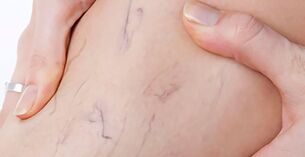
Small protruding veins are still not intimidating, but they should make you think!
The early stages of the disease are characterized by mild symptoms. However, a woman attentive to her health must not lose sight of the first signs of development of varicose veins:
- weight on the legs at the end of the day;
- swelling of the feet;
- the appearance of pigmentation on the skin of the lower legs and thinning of the skin;
- numbness of the limbs, frequent muscle cramps in the legs;
- protrusion of the veins above the surface of the skin;
- the appearance of a pattern of veins, spider veins in the legs.
If, returning home after a day at work, a woman finds her legs in a "deplorable state", one should not blame only uncomfortable shoes or an extra "piece of salt" at dinner. Swelling and heaviness in the legs are the first signs of the development of blood stagnation in the vessels. Remember that vein disease is difficult to treat. Early prevention and timely medical care can significantly interrupt or delay the stretching process. Treatment should be started as soon as possible.
Varicose veins grade 1
The main causes of varicose veins are considered pregnancy, excessive weight gain, prolonged physical activity, sedentary lifestyle, as well as genetic predisposition for such disease. Ordinary people called varicose veins "the disease of flight attendants" due to the peculiarities of this profession and the long standing. This degree of illness is the mildest.

Classify the disease according to different factors. One of the classifications is according to the stages of development of the disease:
- Varicose veins of 1st degree or compensation stage.
- Varicose veins of grade 2 or undercompensation stage.
- Varicose veins of grade 3 or stage of dispensation.
The different stages of the varicose veins in the lower extremities have a radically different treatment. You should not try to deal with the illness yourself. This can only harm and lead to disastrous consequences. It is best to seek help from a competent specialist.
The first degree of varicose veins is characterized by edema at night, convulsive nocturnal spasms. Often, people mistake all of these symptoms for common fatigue. However, already at this stage it is necessary to take preventive measures, which include warming the feet to improve general blood flow, light foot massages, regular swimming, cycling.
Varicose veins in the first stage can also manifest as cramps in the calf region. Patients often complain of a feeling of stretching the legs or burning in the muscles. This is increasingly accompanied by pain in the lower extremities.
Already at this stage, the manifestations of the visual nature of varicose veins may be noticeable, which should immediately alert:
- Slight cyanosis of the skin.
- The first spider veins appear in various parts of the body, most often in the legs.
- Visible tortuosity of the veins.
Varicose veins of the first degree are most frequently manifested by these external changes.
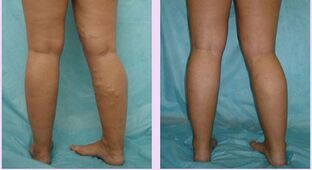
Another important factor in the manifestation of the first stage of varicose veins is the external conditions in which the person is. For example, in a hot environment, symptoms increase, swelling, pain and cramps increase.
Treatment of varicose veins of the first degree
Sometimes doctors recommend the additional use of venotonics, which are quite effective in treating first-stage varicose veins. We must also say about massage: not all types of therapy are suitable for this disease. If after the procedures the pain only intensifies, it is necessary to change the approach when choosing the massage complex.
It is worthwhile to provide cold and relaxing baths for your feet more often, which will calm the muscles, relieve swelling, help reduce pain and remove fatigue. But hot baths should be excluded, as they do not improve the condition of limbs with varicose veins.
Doctors can recommend the following treatments for this type of varicose veins:
- Sclerotherapy - a special medicine is injected directly into the vein with a needle. The action of the medication aims at the resorption of the veins, strengthening the weak walls of the blood vessels, blocking blood flow in the desired area.
- Ozonotherapy - an action that aims to strengthen blood vessels, reabsorption of varicose asterisks.
Each of the above options is very effective. However, the maximum effect can be achieved only if all the recommendations that must be followed after the procedures are used.
Wearing special compression suits is essential. This element helps to create pressure in the veins, thus preventing them from expanding further.
Causes of the disease
There are more than fifty reasons that can trigger a change in the venous system. Especially susceptible to the disease are people whose profession is associated with stress on the legs and sedentary activity: salespeople, hairdressers, programmers, accountants, drivers.
Scientists have conducted many years of research and have identified the main factors that cause varicose vein changes:
- Hormonal changes in the body: pregnancy, menopause, adolescence;
- Obesity to any degree;
- Genetic predisposition. 70% of children whose parents suffered from venous insufficiency develop varicose veins;
- Weak muscular system;
- Wear uncomfortable underwear: tight elastic stockings, tights for men;
- Lack of activity and physical activity;
- The habit of sitting with one leg on the other;
- Rare change in body position: long standing, lying down, sitting;
Chronic diseases: diabetes mellitus, high blood viscosity.
Of the ten patients with varicose veins, eight are women. The weaker sex is subject to venous pathologies due to forced hormonal interruptions during pregnancy, after childbirth, during menopause. The second important factor why women suffer from leg pain more often than men is the love for high heels.
Rules and guidelines
In the initial stage of varicose veins, the patient is advised to follow the rules:
- Walk once or twice a day. You should walk at a leisurely pace, stopping periodically for rest.
- Wear comfortable shoes with a heel not exceeding 3 cm. The upper part of the shoe should not have a pulling device, the laces are not tied as tightly as possible.
- Exercise at the gym twice a week. The loads are selected individually by a doctor and trainer.
Review your diet. Foods exclude foods with high sugar content, fatty meats, flour products and starchy vegetables. Most of a varicose vein patient's diet consists of steamed or boiled vegetables. Fried and spicy foods are not recommended.
- The legs need to rest at night. Blood flow will increase if you lift your legs and throw them on a high pillow or on the back of a sofa.
- If the work involves few movements, it is recommended to lubricate the feet with refreshing gels or ointments containing heparin.
- Special compression garments or elastic bandages are worn every day. The special underwear is selected by a doctor. The peculiarity of compression garments is in the compression function. The pressure in the body occurs with different intensities, which forces the blood to circulate with force.
- Change position frequently. If you have to sit constantly at work, get up and sit down several times every 30 minutes. Exercises help prevent varicose veins and hemorrhoids.
Treatment of different stages
Effective therapy in the early stages can have the opposite effect on advanced pathology. The choice of treatment methods must be appropriate to the stages of varicose veins:
Compression T-Shirt
It is used in all stages of varicose veins; however, the degree of compression should differ significantly at different stages of disease progression. In the initial stage of varicose veins, compression is used for prophylactic purposes during standing and sedentary work.
Compression can stop the development of varicose veins, but before medical use it is necessary to consult a phlebologist, as compression is dangerous because it worsens the problem of venous flow. In the stages of compensation and subcompensation with perceptible edema and varicose veins, underwear of the first and second compression classes is usually prescribed.
The third class of compression is used in cases of severe venous insufficiency. If lymphatic edema occurs, wear fourth grade underwear. The hospital shirt is used for hospital treatment.
Folk remedies
Traditional medicine helps to treat varicose veins in the early stages. The following tools are widely used:
- application of cabbage leaves
- potato, absinthe and garlic compresses;
- chestnut tinctures,
- decoctions of hops and nettles.
However, the ease of use, accessibility, smooth action of folk remedies are combined with their low efficacy (in comparison with medicines), so the enthusiasm for these methods is charged with the progression of the disease. Herbal medicines and compresses should be used after medical advice and serve only as an aid to the main treatment.
Hirudotherapy
Leech treatment is indicated in rare cases of advanced stages of varicose veins. Sometimes, leeches are prescribed for thrombophlebitis.
Leeches can cause allergies and trophic ulcers that aggravate varicose veins. Currently, the method is being supplanted by non-traumatic drugs that contain anticoagulant components.
Medicines
Medications can help relieve symptoms. Tablets, capsules based on grape extract, brown, which are biologically active additives, are effective in the initial stage of varicose veins.
Aid is prescribed in the clearing phase. Most ointments and gels contain heparin, which prevents blood clotting. To a large extent, the effect of ointments and gels is caused by massage during application.
But, in the decompensation phase, the application of such products can cause additional skin manifestations. Symptom relief with medications is usually temporary and does not cure the underlying cause.
Operations
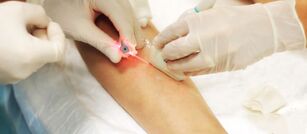
Laser coagulation and sclerotherapy are minimally invasive techniques to exclude veins from the bloodstream. They are used for small diameters of varicose veins in the early stages of varicose veins (when getting rid of spider veins, meshes).
Laser endovasal coagulation of varicose veins
Phlebectomy
Surgical removal of the veins is indicated in the third stage of the disease, accompanied by trophic ulcers and complications. In some cases, the varicose veins in the legs do not develop according to the model presented in the stepwise classification. For example, the symptoms of the first stage may be completely absent: a picture of undercompensation appears immediately.
Or, as the disease progresses, some signs of varicose veins do not add up to the symptoms of the previous phase, but disappear. Therefore, in the beginning of the 21st century, the Russian phlebologists, in addition to the gradual approach, adopted the international classification (CEAP), in which, when diagnosing the severity of the disease, the facts of the individual characteristics of the course of varicose veins and thetreatment effects.
Symptoms
Symptoms of pathology at the beginning of varicose veins do not cause people to think about venous disease:
- feeling of heaviness in the legs;
- fatigue after walking.
They tend to be associated with flat feet, unusual high heels, uncomfortable new shoes, lumbar osteochondrosis.
And only the visual detection of dilated cyanotic veins under the skin raises the suspicion of the development of varicose veins.
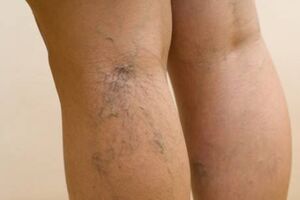
The vascular mesh as the first sign of varicose veins appears more frequently under the knees
Women go to the doctor when they notice unpleasant aesthetic defects in the form of reddish venous "spiders" on the legs, under the knees and on the skin of the thighs.
The “influx” of young women seeking treatment for a phlebologist specializing in venous diseases is usually associated with the next summer season on the beaches, taking care of their appearance and not their health. With the help of pills, they want to restore beauty to the skin of the legs.
Pregnant women are more aware of their condition. In addition to the aesthetic changes, they notice difficulty walking, increased fatigue at night.
The initial stage of the disease is indicated by the disappearance of clinical symptoms after bedtime.
You can be sure by doing this experiment: measure your leg volume at the level of your ankles or calf muscles in the morning and evening after work. If the difference is greater than 1 cm, there are signs of initial varicose veins.
Appears later:
- pain in the legs;
- swelling of the feet;
- feeling of fullness and heaviness in the legs;
- muscle cramps at night;
- dilated veins become dense "snake" cords with darkened areas of the skin.
These signs are indisputable manifestations of venous insufficiency and require treatment.
The main causes of varicose veins in women
Fatigue and edema may be the first manifestations of venous blood flow disorder
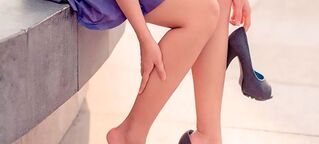
The sex hormone estrogen plays a special role in the development of varicose veins in women. Its action leads to problems such as weight gain, depression, swelling, drowsiness, dry mucous membranes. This hormone increases the permeability of small vessels. The fluid leaves the bloodstream easily, the blood starts to flow less. Excess liquid accumulates in the surrounding tissues. These factors contribute to the development of stagnation in the vessels of the lower extremities.
Reasons to increase estrogen in women:
- An imbalance in the production of estrogen-progesterone. It occurs as a result of a decrease in the level of progesterone in the woman's body;
- Chronic stress. During stress, the body produces cortisol, which in turn inhibits progesterone synthesis;
- Pregnancy. During pregnancy, the amount of estrogen in the woman's body increases;
- Taking contraception. Varicose veins occur as a side effect when taking these drugs;
- Liver disease, because estrogen is removed from the body by the liver. With its malfunction, this hormone accumulates in the body;
- Changes in age-related hormone levels also lead to an imbalance of sex hormones with estrogen predominance.
Separately, the reasons for the development of varicose veins must be noted overweight and a genetic predisposition for this disease. If being overweight can and should be fought for health in general, genetic predisposition cannot be avoided. As a result of these factors, varicose veins are significantly "younger" and are now found frequently in girls aged 16 to 20 years.
Complete liver function is important to maintain normal hormone levels. In addition to removing excess hormones, it participates in the synthesis of substances - progesterone and estrogen precursors. To improve your work, you need physical activity, good nutrition and minimizing the intake of toxic substances in the body.
Treatment of varicose veins with traditional medicine
The treatment of varicose veins in the legs with medication is the most effective way, suitable for almost all patients. A wide variety of medications allows you to choose a medication that is best suited for long-term treatment.
Medicinal methods for treating varicose veins of the legs
Venotonics are among the most effective drugs for the treatment of this disease. Venotonics are drugs that increase the tone of the veins and improve the blood flow of the veins.
These pills can prevent the formation of varicose veins and characteristic nodules.
Application of ointments
The best treatment for varicose veins in the legs is an integrated approach, which includes medicines in the form of pills, as well as the use of gels and ointments for the external treatment of problem areas.
Varicose vein ointment on the legs also helps to improve blood flow and prevent the formation of blood clots.
These funds are recommended for use only after consulting a doctor, who will also determine the duration of treatment and the regimen of use.
Don't self-medicate - it can further damage the patient's already bad conditions.
Consequences of varicose veins.

Varicose veins can lead to the development of trophic ulcers in the legs, thrombosis in the varicose vein system, thrombophlebitis, pulmonary embolism (instant death) in the midst of apparently complete health.
Complicated stages of varicose veins require surgical intervention. Although varicose veins suffer more often in women, men are also affected by this disease, mainly for hereditary reasons.
A man under 40 can appear on the operating table and radical measures are used to cure him of varicose veins - the diseased veins are removed.
Removing varicose veins is easy.
In the groin, the surgeon makes an incision, where the great saphenous vein affected by varicose veins flows into the femoral vein. The vein is exposed, ligated and excised, and a second incision is made in the ankle. With the help of a special metal probe, which is inserted into the lumen of the vessel, the entire dilated vein is removed.
In the future, with the correct technology of the operation, there will be no relapse. The blood supply to the leg is distributed to other vessels and, after 2 weeks, everything is completely restored.
Risk factors that predispose to the development of varicose veins.
- Genetics and pathology of connective tissue;
- Female;
- On hormonal drugs: progesterone, estrogen;
- Pregnancy;
- Age: most common after 50;
- Overweight and physical inactivity;
- Prolonged standing (standing work: hairdresser, salesman, teacher, etc. );
- Obesity.
Symptoms and signs of varicose veins and chronic venous insufficiency.
| Symptoms of varicose veins | External signals |
| Sore pains | Telangiectasia |
| Heavy legs | Reticular veins |
| Fatigue | Varicose veins |
| Swelling | Tromboflebitis |
| Itchy skin | Hyperpigmentation |
| Discomfort in the legs | Bleeding from the trauma node |
| Calf cramps | Ulceration |
Varicose vein treatment options.
The choice of treatment depends on the diameter and type of varicose veins
- Varicose veins of the saphenous veins
- Medical therapy
- Elastic compression and leg bandage
- Sclerotherapy by injection
- Foam sclerotherapy
- Laser therapy
- Miniflebectomy
Dear women, varicose veins can wrap you in skirts and long pants forever. If pills and ointments are unable to get your legs back to normal, then the only safe way to remove enlarged veins remains. In what way and where, it is only after consultation with a phlebologist specialist. Veins can now be treated surgically without hospitalization, without anesthesia, without incisions, with high precision. You just need to take a step towards your health.
Detailed information on varicose veins, symptoms, disease prevention, special exercises, treatment methods and necessary nutrition can be found on the website: ovaricoze. ru
How varicose veins are manifested in the early stages. Why he is dangerous
As a rule, reticular varices are painless. Therefore, the most frequent complaints that patients refer to doctors are aesthetic defects - visible reticular veins.
In more rare cases, the appearance of such a varicose mesh is accompanied by a burning sensation or other changes in the sensitivity of the skin.
In addition to these symptoms, the first stage of varicose veins manifests itself:
- weight on the legs;
- increased leg fatigue;
- cramps in the muscles of the lower extremities, especially at night;
- itching at the appearance of the vascular network;
- swelling of the feet and legs.
To prevent disease progression, it is necessary to start treatment in time
Therefore, it is important to consult a phlebologist, angiologist or vascular surgeon in a timely manner, who will tell you what to do with these skin formations. To begin, a specialist will perform an exam and prescribe the additional tests needed, which will help to identify the causes of the appearance of asterisks or meshes, as well as to establish the degree of impaired venous circulation
To determine the degree of vascular injury and its insufficiency, do:
- complete blood count (shows whether the patient has anemia or thrombocytopenia);
- biochemical blood test (detects blood clotting disorders or liver and kidney function);
- general urinalysis (detects kidney problems);
- vascular ultrasound - duplex angioscanning (reveals vascular wall pathology and blood flow disorders);
- Radiographic phlebography with contrast (determines the location of the venous lesions and the degree of impairment of their functions).
If you do nothing after the first signs of reticular varicose veins are detected, you can:
- inflammation adhesion and development of thrombophlebitis of the superficial veins of the lower extremities;
- transition of the pathological process from the superficial veins of the lower extremities to the deep ones;
- thrombosis of venous vessels. If thrombosis occurs in the venous vessels of the head, it is dangerous for strokes and sinus thrombosis;
- thromboembolism of the pulmonary arteries is a deadly complication that occurs due to the separation of a thrombus from the vessel wall and the blocking of the lumen of the pulmonary arteries.
If you ignore the appearance of incipient reticular varices and do not start treatment in time, the disease will progress. Then, the development of complications will become inevitable.
Prevention
Don't forget preventive measures. For prevention, you need to devote time to sports.
Avoid excessive physical effort. Wear comfortable shoes with low heels (up to 4 cm). Remember that hot showers, baths and saunas have an adverse effect on the health of your legs.
And following these simple guidelines will help prevent the development of this disease:
- try to get rid of bad habits - alcohol consumption and smoking negatively affect the state of your blood vessels;
- compression therapy - wear medical stockings, tights and a high top;
- diet, weight control (overweight people are more likely to suffer from varicose veins), exclude fatty meats and poultry, give up spicy and salty foods, be sure to include vegetables and fruits in the diet; massage
- - get into the habit of giving your feet a light massage after a hard day's work. This will help you relax and improve your body's natural blood circulation.
Any disease is always easier to prevent than to cure. Be healthy!












































